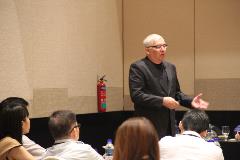Greulich-Smith Tamsin Emma Maria, Member, IT Strategy and Management
Omnichannel isn’t a new concept. The promise of seamless, consistent customer experience, across engagement channels, blending online and offline services for one holistic offering, is made real through Omnichannel applications.
Although leading edge retailers, such as Burberry and John Lewis, have been developing their Omnichannel offerings for several years now, the concept is arguably still short of being mainstream. Hence, in November 2014, NUS-ISS held a thought leadership conference dedicated to the Omnichannel era, and looking in particular at one aspect of this burgeoning phenomenon: how service excellence can be maintained while delivering a supercharged Omnichannel experience.

Tim Kobe, on designing the omnichannel
retail experience
The NUS-ISS conference “Service Excellence in the Omnichannel Era” brought together a diverse mix of Omnichannel practitioners to explore some of the opportunities and challenges associated with this transformative new world.
Tim Kobe, founder of Eight Inc, and creator of the iconic Apple retail stores, kicked off proceedings with a captivating look at the design needs associated with Omnichannel retail. He urged retailers to embrace a new way of thinking, driven by a “return on experience rather than return on investment”.
He explained that when we have a great experience, it is almost unnatural not to tell people about it. The aim of retailers and any service provider, should be to aspire towards the provision of outstanding customer service, particularly in a world that makes it easier for us to share our customer experiences through social media. A recent McKinsey report quoted by Tim during his talk, estimates that 50% of purchases arise from word of mouth recommendations, and that 80% of those endorsements come from direct experience. Andrew Roth, Co-Founder of Perx, reiterated this during his subsequent talk, urging businesses to recognise that a powerful opportunity exists in collaborating with your customers. He encourages us to let our customers do our marketing for us, through word of mouth referrals. To do this, we need to ensure our customers’ experiences are happy ones.
As Tim concluded, in a crowded and increasingly competitive marketplace, customer experience is seen as the key to brand differentiation.
This point was strongly echoed by fellow speaker Philip Whittaker, the Chief Marketing Officer at Themed Attractions and Resorts Malaysia. Philip suggested that establishing customer experience as a core brand value creates a corporate focus on stakeholder engagement that will drive all business activity, both internally and externally. This, in turn, allows you to exceed customer expectations in order to truly delight, and build loyalty. In Philip’s words “customer retention is the new acquisition”, which is why experience-driven brand values are so crucial.
The key objective of Omnichannel is to optimise customer experience. Therefore, reasoned Philip, understanding what your customer wants is key to creating the Omnichannel experience they desire. Just as critically, however, it is about understanding how your services are currently delivered and where the opportunities lie. Philip explained that this requires you not only to walk in your customers’ shoes, but also in the shoes of your staff. While the customer may be king, it is your staff that will make him feel like royalty.
This human-centric design approach is something NUS-ISS has been helping students understand and corporate clients integrate into their service delivery for many years, through our Service Innovation practice. NUS-ISS Chief of Service Innovation & Design, Stuart Smith stated during the morning conference discussion “Online or offline, shopping is just shopping to the customer”. In the cut-throat modern retail world, customers don’t care what’s happening behind the scenes, they simply want solutions that work, the way they want them to. Stuart emphasised the need for businesses to innovate, and apply design thinking principles, in order to make Omnichannel a positive rather than overwhelming experience.
Endorsing the human-centric approach to Omnichannel deployment, it was interesting to hear Mark Wee, the Director of Experience Design at Ong & Ong, clarify what is meant by ‘experience’ from a design-perspective. Looking at environment, communication and process considerations, he explained that to get Omnichannel right you need first to consider the holistic aspects of what makes up a human experience. Whilst technology and data can support the solutions, you must start by getting under the skin of the complex factors that create our perception of experience.
No-one is more acutely aware of the multiple facets of this challenge than the Senior Vice President of Hotel Operations at Marina Bay Sands, Ian Wilson. In the hospitality industry, customer experience has always underpinned every aspect of service, and is core to brand values. The continual need to adapt customer experience to suit rapidly evolving expectations presents an ongoing challenge for a hotel operating at almost 100% capacity. Nonetheless, during his talk Ian revealed how Marina Bay Sands has taken the opportunities presented by new technologies to enhance customer service and, at the same time, improve efficiencies. From self-checkout kiosks, to automated valet parking, a move towards Omnichannel is being implemented across all hotel services, creating one streamlined experience, and enhancing an already exemplary quality of customer service with win-win solutions.

Rob Findlay, on user design experience for omnichannel
customer service
Increasingly, consumers expect to be delighted in all arenas, not just in leisure and retail environments. Rob Findlay, the Customer and innovation Culture Lead at DBS, presented a compelling presentation on the potential of Omnichannel beyond its original space. “Why shouldn’t banking be a graceful experience?” he challenged delegates. Applying the same core values of streamlined, consistent customer experience across engagement channels is allowing Omnichannel to transform the way we bank, and DBS is amongst several major financial institutions looking at how they can optimise customer service through Omnichannel.
Rob argued that we should look at Omnichannel as an opportunity to remove ‘friction’ from our customer service systems and create value, regardless of the industry we’re in. Such aspirations apply to all service-based organisations, and hence the concluding panel discussion considered “what next?” for Omnichannel. How might sectors like healthcare or transport benefit, for example?
Omnichannel has emerged as an exciting trend in retail and hospitality sectors, elevating the concept of customer service to the next level, with a genuinely customer-centric approach to service provision. Whilst its implementation and true integration might present challenges, all speakers at the NUS-ISS conference agreed that the opportunities in this experience-driven era have the potential to transform, delight, and strengthen our customer relationships. Omnichannel appears to have catalysed an evolution in customer service, promising scalable, bespoke engagement that we can’t stop ourselves telling people about.